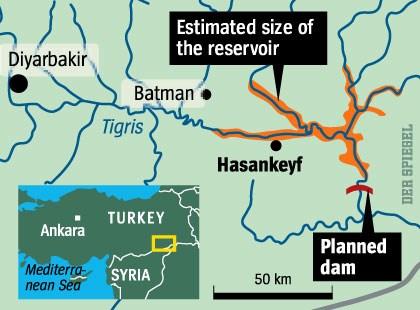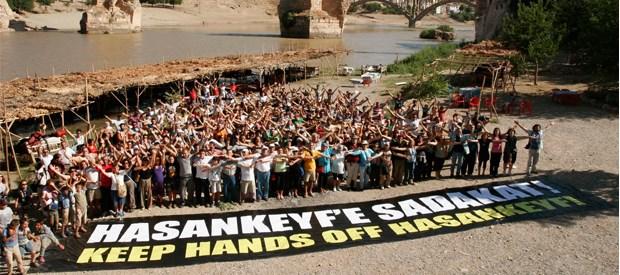
5 minute read
The Ilisu Dam
By Rachel Alm
The flooding of Hetch Hetchy Valley prompted one of, if not the first, conservationist conversations in the United States of America. John Muir, a prominent writer and environmental advocate, reacted very negatively to the proposed construction of the O’Shaughnessy dam by the city of San Francisco. It would provide water for the blossoming city in California, but would simultaneously flood what John Muir called “one of nature’s most precious mountain temples”: The Hetch Hetchy Valley. Recently, the dam has been removed and the valley is no longer a reservoir--in fact, it is slowly but surely re -flowering and the natural fauna are returning.
Dams have always altered the landscapes they sit on, be it in the United States of America or anywhere around the world. They are, by nature, barriers for natural flowing lakes, rivers, and streams. They interfere with the migration patterns of fish and also alter the flora that can grow on the banks of a river if it is no longer flowing in a certain direction. Current dam projects are being proposed all over the world and the implications of their environmental impacts are sometimes completely disregarded.
One of the most controversial current dams is that of the Ilisu dam being built in the country of Turkey across the river Tigris. The dam is proposed to cover an area of 300 square kilometers and will be 136 meters tall. Upon completion, it will help the nation’s growing energy needs by supplying 2-3% through hydroelectric power. Its construction will help ease the impoverished regions of the southeastern area of Turkey. But the dam’s construction has faced political, environmental, and historical backlash. The European leaders that were investing in the project backed out their contributions five years ago because of a failure to put forth an Environmental Impact Statement. The Prime Minister Recep Tayyip Erdogan put forth a decree (that was later shot down by the highest administrative court) to exempt the project and all its facilities from having to issue an EIS.
Environmental groups claim that not only will the dam damage the ecosystem downstream; it will also devastate the town of Hasankeyf, which is directly at the center of the proposed reservoir. Concern over the project stems from the fact that Hasankeyf is a 10,000 year old town--and one of the oldest that is still inhabited. Its history dates back through the Roman and Ottoman empires and it contains valuable cultural artifacts and history. Ercan Ayboga of the Initiative to save Hasankeyf claims that if the reservoir were to flood the town, “we will lose a real treasure”. Archaeologists studying at the site say that not everything has been properly surveyed--letting it flood will destroy everything they couldn’t reach in time. Plans to move the city’s most important artifacts to a cultural museum and park would result in damaged and broken goods, which is worrisome to many experts of the area.
The inhabitants of Hasankeyf and its surrounding areas are also concerned. Not only will it put the city of Hasankeyf underwater, but it will also destroy around 80 villages that are settled within the area. The government is urging people from these areas to relocate by offering them funds to help resettle. The hope is that the resettlement will occur in new towns being built along the reservoir. These towns will be equipped with more modern amenities, such as malls and shopping centers, to better fit with the rapid growth of Turkey’s industry and population.
Photo © Trici Venola. (http://tricivenola.wordpress.com)
But the idea of relocation is far from appealing to everyone. Arif Arslan of the Friends of Hasankeyf Association claims that moving people to new locations won’t improve their lives; it will simply take away what livelihood they always had. He claims the move to the cities will only result in more people falling into the slums and poverty. The Kurdish Human Rights Project backed up that sentiment in May of 2010, saying that “Kurdish villagers and farmers will be unable to benefit from any economic growth because they will be displaced from their homes to the shanty towns of nearby cities such as Diyarbakir and Hakkari, which already suffer from poor infrastructure, overpopulation, unemployment and poverty.”
The nearby town of Ilisu already bolsters a population of relocated individuals, some of which share Arslan’s doubt and anger. “I preferred our old village,” a young man named Mehmet informed the New York Times, “because we had our orchards and our vines and could always make a living if we worked hard.” Many villages have filed for the government assisted relocation, but others have not. Hasankeyf is one such place that hasn’t filed for relocation, and protestors don’t plan on letting that happen anytime soon.
The dam has also spurred tensions between Syria and Iraq as well, whose officials feel that the Tigris River’s power is going to be monopolized by Turkey, even though all three countries have access. Being that the project is no longer backed by European countries, (even Germany, who is considered an ally to the country, stopped providing funds) the dam project has faced many economic setbacks. Its backers hope to see that settled though, as the dam is supposed to bring in a revenue of 300 million dollars a year to strengthen the growing economy. The project was also the least environmentally impactful of the proposed ideas, which included nuclear and thermal plants, according to a team of government-appointed scientists. The fact that many members of this team all once had positions in government has raised questions among environmentalists and advocates speaking out against the project.
Turkish officials believe that the dam is vital to the growth of the nation, and they claim that undergoing the project will improve the country as a whole, while providing clean energy and housing to thousands of people in impoverished area. Opposition says that the stakes are higher and that none of the supposed “energy” will be going towards those who need it most. A http://www.spiegel.de/ woman resident of Hasankeyf named Semra Argun told the Hurriyet Daily News, “If the dam is constructed we lose everything. Our homes, this history and even the graves of those we have lost will go underwater.”
Although with its completion nearly imminent (the dam is expected to open sometime this year), it’s tough to say how much farther these grassroots groups can go. As John Muir fought for Hetch Hetchy, these men and women are fighting against something that is equally as devastating in a time where clean energy may come at the cost of something far greater.

Sources
1. http://www.nytimes.com/2013/02/28/world/ middleeast/construction-of-disputed-turkish-damcontinues.html?pagewanted=all&_r=0
2. http://damocracy.org/?p=791
3. http://www.spiegel.de/international/turkey-s-damcontroversy-we-will-lose-a-real-treasure-a-430470.html
4. http://www.spiegel.de/international/world/protectingturkey-s-treasures-environmentalists-see-one-lastchance-to-stop-ilisu-dam-a-697801.html
5. http://hetchhetchy.org/











